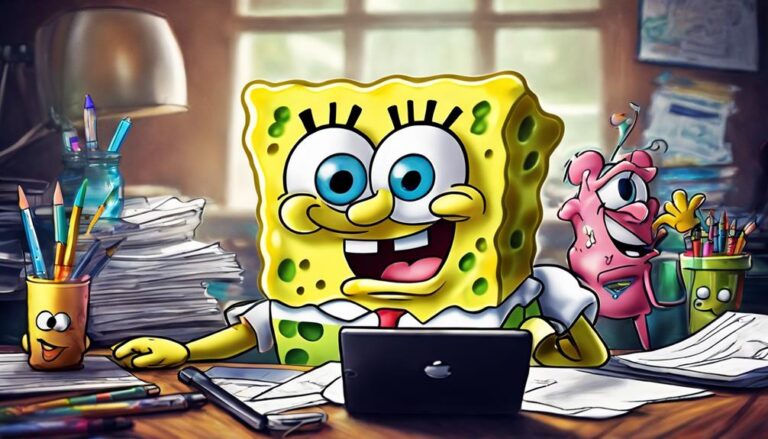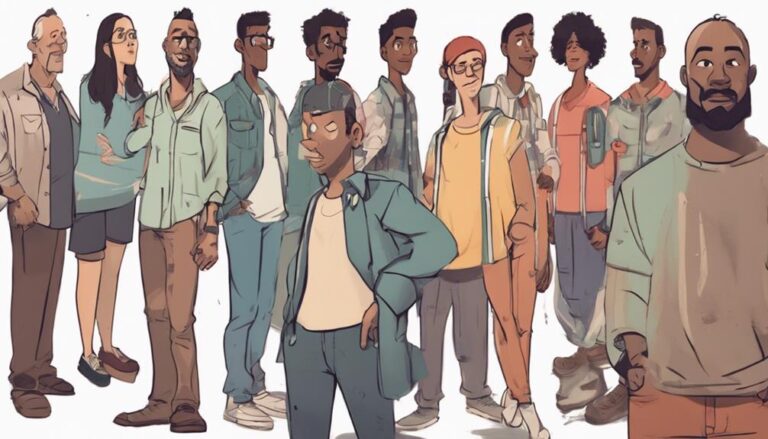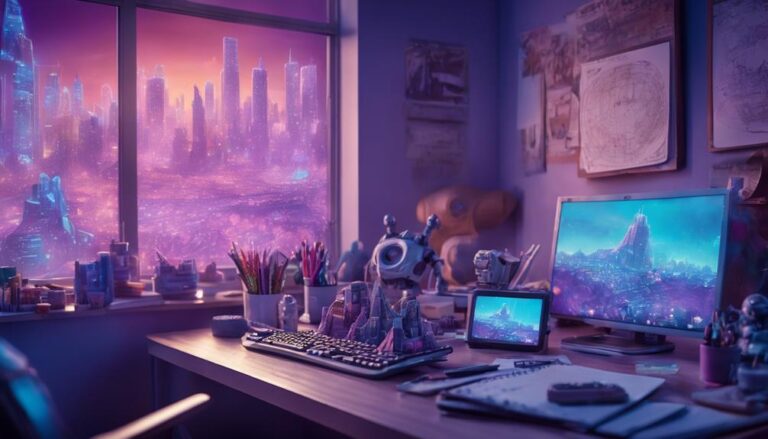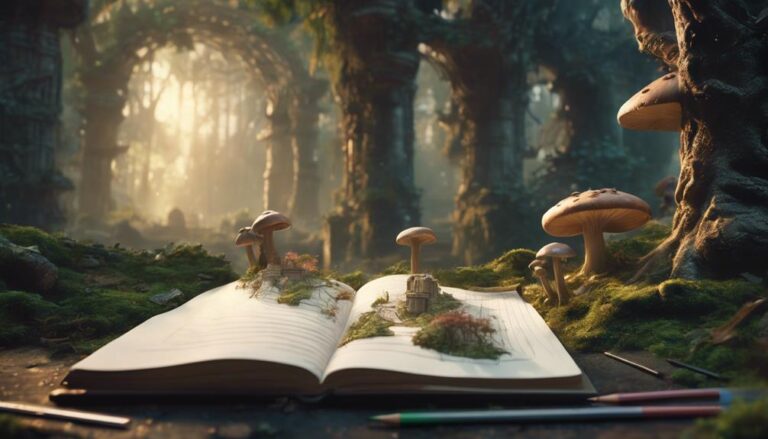What Goes Into Making a Animated Film?
To make an animated film, you'll start by crafting a polished script with well-defined story arcs, pacing, and character development. This will serve as the foundation for detailed character design, world-building, and visual storytelling. Next, you'll focus on voice recording and casting, ensuring that your voice actors understand the tone, pace, and emotional depth of their characters. As you move into production, you'll create animation assets, maintain quality standards, and allocate resources effectively. From there, it's on to post-production, where you'll refine your soundtrack, sound effects, and editing. Every detail you perfect will bring your vision closer to life, and as you continue this intricate process, you'll uncover even more key elements to making an unforgettable animated film.
Key Takeaways
- Developing a solid script with compelling narrative, pacing, and character development is crucial for an animated film's success.
- A detailed production timeline and budget planning enable effective allocation of resources throughout the animation process.
- Voice recording and casting require careful consideration of accent authenticity, character consistency, and voice actor versatility.
- Sound design elements, such as Foley effects and soundtracks, enhance the film's sonic experience and evoke emotional responses from the audience.
- Visual enhancement techniques, including color correction and grading, refine the film's aesthetic and ensure consistency throughout the narrative.
Script Development and Writing
Developing a solid script is the storyboard backbone that brings your animated film to life. It's the foundation on which your entire project is built, and it's crucial to get it right.
As you start writing, focus on crafting a compelling narrative with well-defined story arcs that engage your audience. Consider the pacing, tone, and character development, ensuring that every element serves a purpose in advancing the plot.
As you work through your script, be prepared to make multiple script revisions. This is a normal part of the process, and it's essential to be open to making changes that strengthen your story.
Don't be afraid to cut scenes, characters, or dialogue that aren't working. Every revision brings you closer to a polished script that effectively conveys your vision.
When revising, pay attention to pacing, ensuring that your story flows smoothly and keeps your audience engaged.
Make sure your story arcs are well-defined and satisfying, with clear character growth and development. With a solid script in place, you'll be well on your way to creating an animated film that captivates and inspires your audience.
Character and Story Design
With a solid script in place, you can start bringing your characters to life through detailed design.
This involves creating character profiles, including their backstory, personality traits, and motivations.
You'll also want to develop character arcs, outlining how they change and grow throughout the story.
This will help you create more nuanced and relatable characters.
As you design your characters, consider their role in the story and how they interact with the world around them.
World building is a crucial part of the design process, as it helps to establish the rules and logic of your animated world.
This includes creating a visual aesthetic, designing environments, and developing the culture and history of your world.
In addition to characters and world building, you'll also want to focus on visual storytelling.
This involves using composition, color, and lighting to convey mood and atmosphere.
By combining these elements, you can create a rich and immersive story that engages your audience.
Voice Recording and Casting
As you move forward with bringing your animated film to life, you'll often find yourself recording voice tracks for your characters.
This crucial step requires careful planning, attention to detail, and a deep understanding of your characters' personalities.
Key Considerations for Voice Recording and Casting
1. Vocal direction: Ensure that the voice actors understand the tone, pace, and emotional depth required for each scene.
Provide clear direction on how to convey emotions and emphasize key dialogue points.
2. Accent authenticity: Verify that voice actors can accurately portray regional accents and cultural nuances.
This attention to detail can make or break a character's believability.
3. Character consistency: Maintain consistency in voice tone, pitch, and style throughout the recording process.
This is especially important for characters with distinct personalities or accents.
When casting voice actors, consider their range, versatility, and ability to take direction.
Hold auditions to find the perfect fit for each character, and be prepared to provide guidance and support throughout the recording process.
Effective voice recording and casting can elevate your animated film, bringing your characters to life in a way that engages and captivates your audience.
Animation Production Process
The animation production process unfolds like a complex tapestry, weaving together multiple threads of creativity, technology, and meticulous attention to detail.
You'll begin by creating a detailed Production Timeline, outlining each stage of production, from pre-production to post-production.
This timeline will serve as a roadmap, guiding your team through the entire process and ensuring that deadlines are met.
Budget Planning is also crucial during this stage, as you'll need to allocate resources effectively to achieve your artistic vision.
You'll need to consider the cost of software, equipment, and personnel, as well as the time required for each task.
With a solid plan in place, you'll be able to manage your budget efficiently and make adjustments as needed.
As you move into production, your team will start creating the animation assets, including character models, environments, and special effects.
You'll work closely with your team to ensure that each asset meets your quality standards and aligns with your overall vision.
Throughout the process, you'll be constantly reviewing and refining your work, making adjustments to ensure that the final product meets your creative goals.
Music and Sound Design
When crafting the music and sound design for your animated film, you're tasked with creating an immersive aural experience that elevates the narrative and visuals.
You'll start by developing a soundtrack that complements the film's tone, genre, and pacing, which may involve commissioning an original score or selecting licensed tracks that fit the bill.
Meanwhile, you'll also be adding sound effects to enhance the visual elements, from Foley recordings that bring characters to life to FX that simulate environments and actions.
Creating the Soundtrack
Every animated film relies heavily on its soundtrack to convey emotion, establish atmosphere, and guide the audience through the narrative.
When creating the soundtrack, you'll work closely with the composer to develop a music composition that complements the film's tone and theme.
- Orchestral scores: Decide whether to use a live orchestra or digital instruments to create the score. This choice will significantly impact the overall sound and feel of the music.
- Thematic development: Create recurring themes that represent characters, locations, or ideas in the film. This will help to establish continuity and depth in the narrative.
- Emotional resonance: Ensure the music evokes the desired emotional response from the audience. This might involve experimenting with different melodies, harmonies, and instrumentation to find the right balance.
When composing the music, consider the pacing, tone, and mood of each scene.
You may need to create multiple versions of a piece to ensure it fits the film's evolving narrative.
Adding Sound Effects
Adding Sound Effects
Diving into the world of sound effects, you'll discover a rich tapestry of audio elements that can make or break the immersive experience of your animated film. Sound effects are crucial in creating a believable atmosphere, drawing the audience into the world you've created. Foley artistry, the process of recreating everyday sounds in a recording studio, is a vital part of sound design. From the rustling of leaves to the creaking of wooden doors, each sound effect is carefully crafted to enhance the visual elements of your film.
| Sound Effect | Description | Implementation |
|---|---|---|
| Footsteps | Creating realistic footsteps requires attention to detail, taking into account the surface, footwear, and pace. | Record Foley artist walking on various surfaces. |
| Water Splashes | Designing water splashes involves manipulating sound waves to achieve the desired sonic effect. | Use a combination of field recordings and sound design software. |
| Fire Crackles | Simulating the crackling of flames requires a deep understanding of sound waves and frequency manipulation. | Record and edit fire sounds, adjusting frequencies to achieve the desired effect. |
| Wind Gusts | Creating realistic wind gusts involves layering multiple sounds to achieve a natural, organic feel. | Record and combine various wind sounds, adjusting levels and timing. |
| Door Creaks | Designing creaking doors requires attention to detail, taking into account the type of door and the environment. | Record and edit Foley sounds, adjusting frequencies to achieve the desired effect.
Final Editing and Visual Effects
You're now entering the final stages of post-production, where you'll refine the overall look and feel of your animated film through final editing.
This involves integrating sound design elements, such as Foley effects, to enhance the overall sonic experience.
Next, you'll tackle the color correction process, which requires a keen eye for detail to ensure a cohesive visual aesthetic that supports the narrative.
Sound Design Elements
As you enter the final stages of post-production, sound design elements play a pivotal role in elevating your animated film's overall impact, particularly during the final editing and visual effects phases.
This is where the magic of sound waves comes alive, transforming a silent visual world into a rich, immersive experience.
During this phase, Foley artists meticulously craft and record custom sounds to enhance your film's sonic landscape.
They carefully select props, like creaking doors, crunching footsteps, and rustling fabrics, to create an authentic auditory experience.
By combining these sounds with clever editing techniques, you can create a truly engaging atmosphere that draws your audience in.
Some key sound design elements to consider in your animated film include:
- Diegetic vs. non-diegetic sound: Balance the sounds within your film's world (diegetic) with external sounds (non-diegetic) to create a layered sonic experience.
- Sound wave manipulation: Experiment with frequency, amplitude, and panning to create unique sound effects and emphasize key visual elements.
- Foley integration: Seamlessly blend custom Foley recordings with your film's score and dialogue to create a cohesive, engaging soundtrack.
Color Correction Process
The color palette of your animated film is its visual heartbeat, pulsating with every scene and character interaction.
It sets the tone, evokes emotions, and draws the audience in. As you dive into the color correction process, you're refining your film's overall aesthetic.
This stage is crucial in ensuring consistency and cohesion throughout your narrative.
You'll work closely with your colorist to establish a distinct color palette that reflects your story's themes and atmosphere.
Grading techniques such as lift, gamma, and gain will be applied to balance and fine-tune the colors.
You'll also experiment with color curves, hue vs. saturation, and other advanced tools to achieve the desired look.
Your colorist will use software like DaVinci Resolve, Baselight, or Nuke to create and apply the color grades.
Throughout the color correction process, you'll review and refine the grades, making sure they align with your artistic vision.
This iterative process ensures that your film's color palette is polished, consistent, and engaging.
Frequently Asked Questions
How Do Animators Stay Motivated During Long Production Periods?
To stay motivated during long projects, you take creative breaks, working on personal art or experimenting with new techniques. You also participate in team celebrations, marking milestones and sharing successes with colleagues to boost morale.
What Software Is Used for Animation Rendering and Lighting?
You utilize software like Arnold, V-Ray, or RenderMan for rendering, often relying on render farms to process complex scenes. Additionally, you employ light mapping techniques in tools like Maya, 3ds Max, or Blender.
Can Animation Studios Work on Multiple Projects Simultaneously?
You can manage multiple projects simultaneously by balancing project timelines, assigning tasks based on team dynamics, and leveraging agile methodologies to ensure efficient workflow, quality control, and meeting deadlines, while maintaining artistic integrity and creative vision.
How Are Animated Films Distributed Globally to Theaters?
You'll navigate complex global distribution by considering cultural adaptations, territorial restrictions, and format conversions to deliver animated films to theaters worldwide, ensuring each region receives a tailored version that meets local standards and regulations.
Are Animation Studios Open to Hiring Freelance Artists?
When seeking freelance work, you'll find many animation studios open to hiring you, as they often require specific skills or styles, so be prepared to negotiate freelance rates and showcase your best work in your artist portfolios.
Conclusion
As you bring your animated film to life, you've navigated a complex, multi-faceted process. From developing the script and designing characters, to voice recording, animation production, music composition, and sound design, every step has required precision and creativity. With final editing and visual effects complete, your vision takes shape. Each element, carefully crafted, now converges to evoke emotions, spark imagination, and create a cinematic experience that will captivate audiences worldwide.







